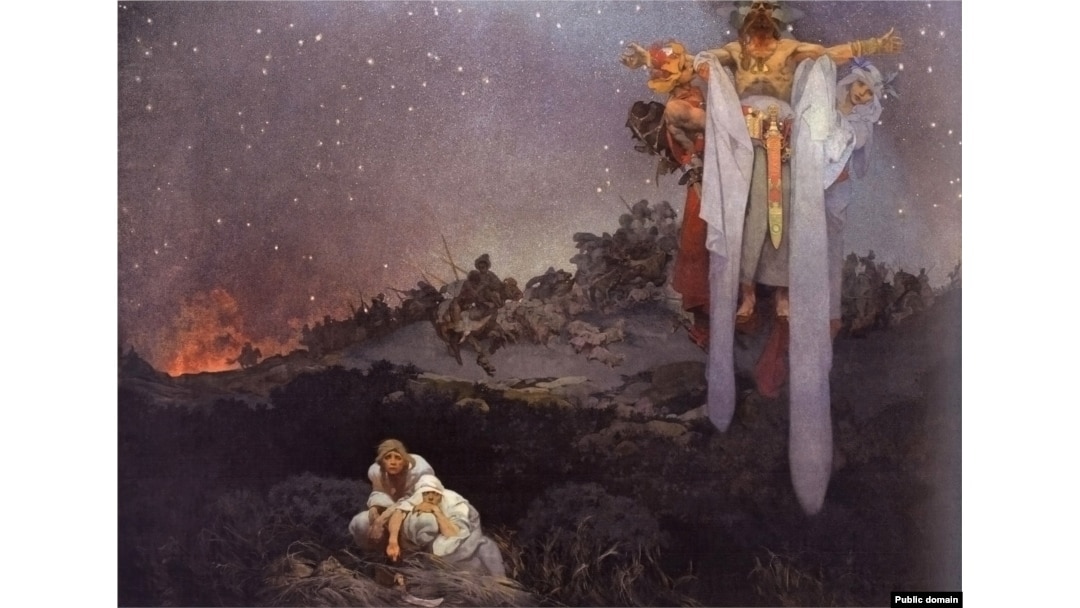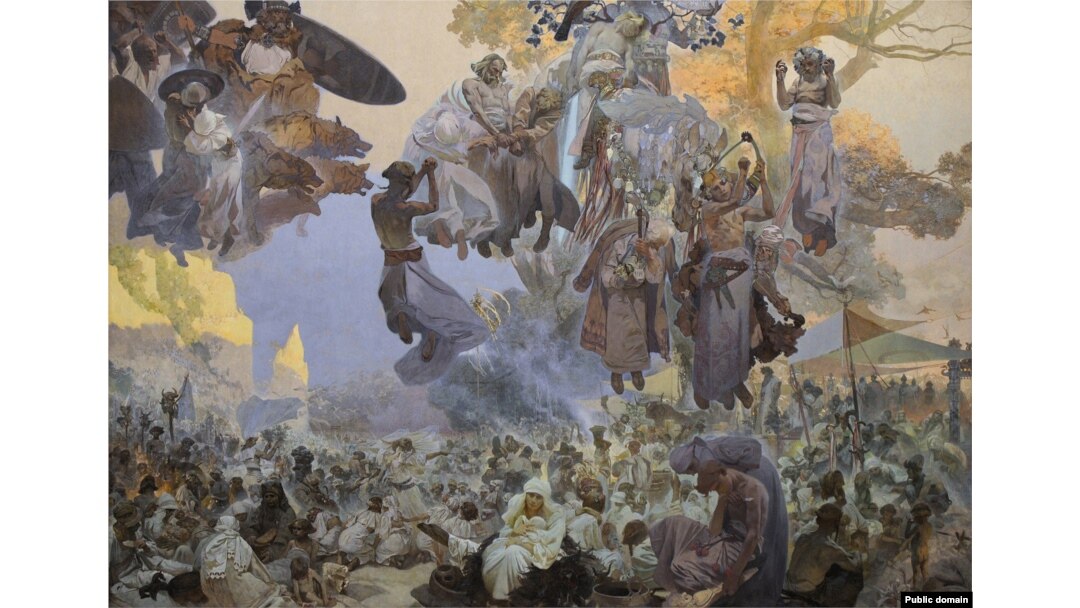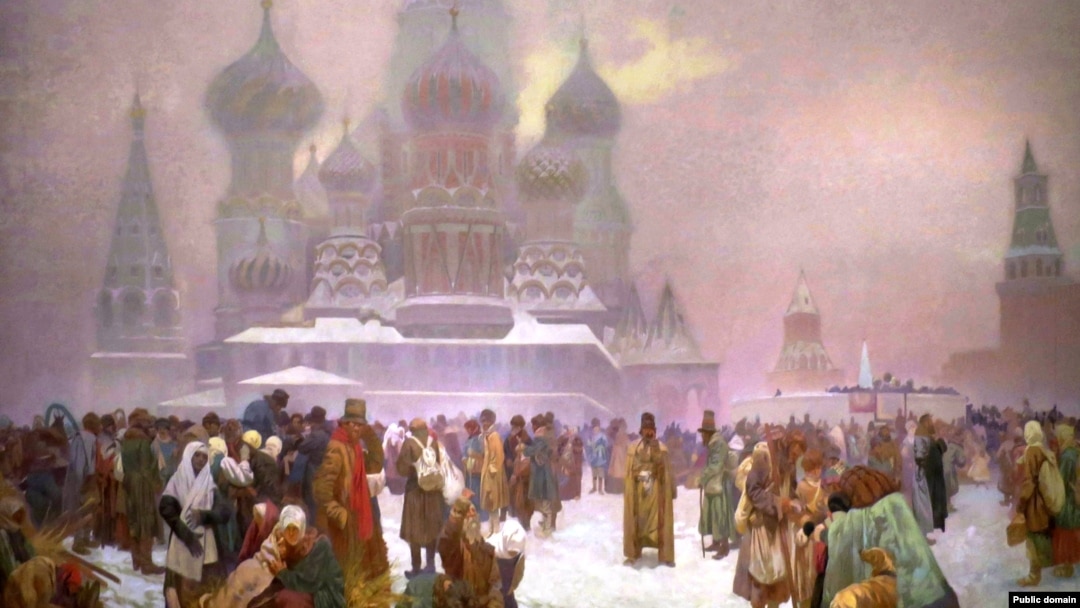With news that a probable home has been found for the Slav Epic, a series of masterworks by the Czech artist Alphonse Mucha, we take a look at what the paintings represent.
There have been years of legal wrangling between the city of Prague and the descendants of the artist Alphonse Mucha over his Slav Epic, a 20-painting sequence telling the story of the Slavic people. Now, an agreement finally appears to have been reached to house the work permanently in Prague.
Mucha gifted his masterpiece to Prague in 1928 with the proviso that an exhibition space had to be built to house the paintings -- some measuring more than 8 meters wide. That building never materialized. But the developer of a retail center scheduled to open in 2026 in central Prague has vowed to build a space for the epic to be displayed.
Mucha’s grandson, John Mucha, told The Art Newspaper that “if everything goes ahead as planned” with the development of the exhibition space, he would drop ongoing litigation -- allowing the paintings to be displayed in a permanent home.
Here is a summary of what each of the canvases represent:

The Slavs In Their Original Homeland
Mucha set the opening of the story of his people around the 5th century, when Slavic tribes of Central and Eastern Europe had no unified political structure in place and were vulnerable to attacks from Germanic militias. The couple in the foreground is hiding in a forest as raiders burn their village. Hovering above the scene is a pagan priest flanked by two youths who represent both war and the peace that fighting for one’s freedom can bring.

The Celebration Of Svetovid
Beginning around the 8th century in the northwest lands of the Slavic tribes, Slavs built a temple to the pagan god Svetovid on Rugen Island in what is now Germany. Danish forces destroyed the temple and the land was soon repopulated with ethnic Germans.
This painting shows Slavic pilgrims, dressed in white, making the journey to Svetovid for a celebration. Most are oblivious to their enemies, represented by wolves at the top left, as they advance on the sacred island.
The Introduction Of The Slavonic Liturgy
By the mid-ninth century, many Slavs had adopted Christianity. The new faith was profoundly strengthened when the Slavic monks Cyril and Methodius translated Christian texts into a language now known as Old Church Slavonic. The script they created for the task is the basis for the Cyrillic alphabet used in Russia, Ukraine, Serbia, Bulgaria, and many other countries today.
The painting depicts Methodius in the top left wearing a white hood as he returns triumphantly from Rome where he’d received the blessing of the pope to continue translating the Bible into a Slavic-friendly text. Figures floating at the top right represent rulers who helped the spread of Christianity in Slavic languages.
The painting’s subtitle, Praise The Lord In Your Native Tongue, captures the cultural significance of the moment.
The Bulgarian Tsar Simeon
When the followers of Methodius were evicted from Moravia, Tsar Simeon (at the center of the painting) invited them south to his Bulgarian kingdom to continue translating Christian texts.
In this painting, members of Simeon’s court watch from the side as Moravian translators clutter the royal residence. Simeon is depicted in the midst of an impassioned debate.
The Bohemian King Premsyl Otakar II
Known as the Golden King for his enormous wealth, King Otakar II worked to forge close bonds with other Slavic rulers during the 13th century. Mucha depicted the Bohemian ruler extending his hands in friendship to two guests at the wedding of Otakar’s niece and the son of the king of Hungary.
The Coronation Of Serbian Tsar Stepan Dusan
Girls in traditional costumes lead a procession as the Serbian Tsar Stepan Dusan -- described as "perhaps the most powerful ruler in Europe" -- is crowned in Skopje in 1346. Dusan is in the center of the image dressed in white and gold.
Dusan was lauded for vastly expanding territory held by Slavs in the south of Europe, and for a set of laws he enacted that served as a kind of medieval constitution.
Milic Of Kromeriz
Jan Milic was one of the first Christian men to publicly turn against what he felt was corruption within the Roman Catholic Church. In 1363, he walked away from his clerical titles and became a simple preacher.
In this painting, Milic is depicted in a blue cloak with a beard atop scaffolding during the construction of a shelter for “penitent prostitutes.” The women at the bottom of the frame, apparently moved by Milic’s sermon, are seen in various stages of replacing their gauzy streetwear with the somber clothing of nuns.
Master Jan Hus Preaching At The Bethlehem Chapel: Truth Prevails
Jan Hus was another outspoken clergyman who criticized the excesses of the Roman Catholic Church. His Czech-language sermons inside the nondescript Bethlehem Chapel in Prague’s Old Town electrified congregations. In 1415, after clashing repeatedly with church leaders, he was charged with heresy and burned at the stake.
The Meeting At Krizky
The cruelty of Jan Hus’s death sparked widespread anger in Czech lands and an underground movement opposing papal authority rapidly developed. This work depicts a secret gathering outside of Prague in 1419. A preacher named Koranda, wearing a brown cloak in the center right of the painting, calls on a crowd to take up arms as dark clouds gather in the background.
After The Battle Of Grunwald
The Teutonic Knights were a formidable Christian military force that regularly raided pagan Slavic territory in northeastern Europe through the 1300s. In 1410, a coalition of Polish and Lithuanian fighters advanced on the knights near their base in what is today the eastern part of Germany -- devastating the Germanic fighters in an infamous battle at Grunwald.
This painting depicts the triumphant but shell-shocked Polish King Wladyslaw taking in the cost of the battle.
After The Battle Of Vitkov Hill
Mucha returns to the followers of Jan Hus, known as the Hussites, in this painting of the aftermath of a battle on the edge of Prague. The battle was fought in the summer of 1420 after Sigismund, the fiercely anti-Hussite Holy Roman Emperor, attempted to crack down on Prague’s religious rebels. A small band of Hussites resisted Sigismund’s army from their fortified position atop Vitkov Hill before a military force led by the legendary one-eyed warrior Jan Zizka surprised the invasion force from behind.
The painting captures Zizka (right) in a shaft of sunlight standing above the enemy’s abandoned weapons during an impromptu religious service.
Petr Of Chelcicky
The misery of the Hussite wars is captured in this scene showing the aftermath of one of countless massacres of villagers by Hussite extremists. In the center right of the scene, the pacifist Petr of Chelcicky pleads with people not to seek vengeance. The Czech spiritual leader believed it impossible to physically destroy evil.
The Hussite King Jiri Of Podebrady
Due to the military endurance of the Hussites, Bohemia was able to crown native Czech Jiri of Podebrady in 1458. The Hussite ruler won popularity for his relatively moderate treatment of Catholics, and by reining in some of the more extreme Hussite factions. But Rome’s Catholic leadership refused to recognize his rule and demanded he return Bohemia to papal control.
This painting shows the king (right) rejecting the demands of one of the pope’s diplomats. In the foreground, a boy indicates the end of cooperation with the Roman Catholic leadership by snapping shut a book titled Roma.
Defense Of Szigetvar Against The Turks By Nikola IV Zrinski
A new chapter in religious conflict opens with this painting of the Siege of Szigetvar by Turkish forces in 1566. The town’s defenders are led by the Croatian nobleman Nikola IV Zrinski. The Ottomans eventually conquered the heavily fortified town in what is now southern Hungary and massacred the inhabitants. But the massive losses suffered by the invaders during the siege delayed Islam’s advance into Europe. A French cardinal later called Szigetvar “the battle that saved [Western] civilization.”
The Printing Of The Bible Of Kralice In Ivancice
The Unity of the Brethren was a religious sect founded on the principles taught by Jan Hus. In Mucha’s hometown of Ivancice, the scholarly brethren printed a Czech translation of the New Testament. In the leafy scene depicted by Mucha, brethren read through a new copy of the bible made by a printing press (right). Bibles printed at Kralice would prove crucial to the preservation of the Czech language through the turbulent events that followed.
The Last Days Of Jan Amos Komensky In Naarden
In 1619, Rome’s new emperor Ferdinand II used military might to reimpose Roman Catholic rule over Bohemia. Thousands fled the region after being given the choice to convert to Catholicism or become exiles.
This painting captures the melancholy death of the beloved Czech educator and philosopher Jan Amos Komensky in 1670. He is seated in a chair on the Dutch coast. The lantern offers what Mucha called “a flicker of hope” in the gloomy scene as Komensky’s followers dream of returning to their homeland.
Holy Mount Athos
Mount Athos is a sacred, monastery-dotted peninsula in northeastern Greece. It has long held significance for Slavs and was under Serbian administration for decades in the 1300s. Mucha visited the peninsula himself.
In this painting, he depicted a crowd of Russian pilgrims paying homage in one of the peninsula’s temples. Angels, some holding images of other Athos monasteries, float above the weary travelers.
The Oath Of Omladina Under The Slavic Linden Tree
Omladina (Youth) was the title given to violent street protesters in Prague in the late 1800s who were opposed to Austrian rule over Czech lands. In an infamous trial, dozens of the protesters received lengthy prison sentences. Mucha painted an idealized nationalist movement, with youngsters and politicians swearing allegiance to “the goddess Slavia” as she watches over from a perch in a linden tree.
The Abolition Of Serfdom In Russia
Russian society was dramatically changed in 1861 when Tsar Alexander II granted some 23 million serfs their freedom. Mucha traveled to Russia in 1913 to research the subject. His painting depicts crowds of Russian peasants milling around uncertainly on Moscow’s Red Square after learning of their new status as free men and women.
Apotheosis Of The Slavs
For the final frame of his epic series, Mucha wove together the themes of the 19 previous paintings and added one near-contemporaneous final detail. In the lower left of the frame, soldiers of World War I are saluted by youngsters waving branches to welcome their return from the trenches.
Many Slavic countries won their independence as the Austro-Hungarian Empire collapsed at the close of hostilities in 1918. The figure at the top of the frame represents the Slavic world stepping into a new era of independence as a Christ-like figure offers guidance from behind.
On January 22, Prague City Museum Director Magdalena Jurikova told RFE/RL that the canvases are being stored in a “secret location” in Prague after a temporary exhibition from 2018 to 2020. Jurikova says the paintings will be moved to the town of Moravsky Krumlov in the spring of 2021 for another temporary display while the Prague development takes shape over the coming years.


